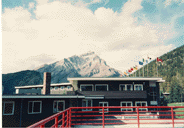
The
town of Banff
has hosted artists since it was founded in 1883. Painters and writers, primarily, came to explore the mountains and their art. In 1933 a small cadre of visionaries, lead by Ned Corbett of the University of Alberta's Extension Department, convinced officials to support the establishment of a summer theatre training program in Banff. Funded by a grant from the Carnegie Foundation, the "School of Drama" was first offered that summer.
Just down the valley at Seebe, A. C. ("Ace") Leighton, a master of landscape painting, had established a small summer painting program. In 1935 Leighton moved his painting program to Banff to share facilities with the drama school. In 1936 the two programs joined with a new music program to become the Banff School of Fine Arts (now known as the Banff Centre for the Arts) beginning the juxtaposition of various artistic disciplines that has become its hallmark
The Centre grew in size and reputation. During his 33 years as director, Donald Cameron transformed the vision of the founders into an internationally acclaimed artistic institution. he raised money, scrounged old buildings, and persuaded Parks Canada to provide a spectacular site on which to create a campus that would do justice to the school he dreamed of building.
 |
Cameron's dream became a reality. Aided by
funds from the Colonel J. H. Woods estate
he began to build the three original chalets
and the administration building that bears
his name. In 1947 the school moved from various
locales around Banff to the beautiful site
on Tunnel Mountain, where it has thrived
ever since.
Over the years the number of programs has
grown, as has the Centre's reputation for
excellence in arts training and education.
Management programs were initiated in 1952.
Conference programs were started in 1953.
Both added to the eclectic approach to educational
programming that set the Centre apart. They
also helped pay the bills and made use of
their buildings during the winter months.
In 1971 winter programs in the visual arts
were launched and the summer session was
extended from six to twelve weeks, and in
1979 a major step was taken with the launching
of the winter programs.
The Centre for the Arts had gone far beyond its beginnings to become a major adult education centre. In 1978 the government of Alberta legislated The Banff Centre Act, which established the Banff Centre for the Continuing Education as an autonomous institution within the Alberta Ministry of Advanced Education, and the Centre for the Arts as a division of the Banff Centre. This administrative shift allowed the centre for the Arts to co-exist and interact with the other divisions of the Banff Centre (Centre for Management and centre for Conferences), yet remain independent and adventurous in its approach to artistic development.
To find out more about the Banff Centre, follow this
link to the Banff Centre's
own home page.